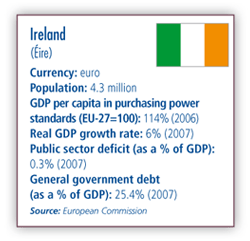Member State profile
The economy of Ireland: whither the Celtic Tiger?
|
| Doonagore castle in County Clare, Ireland © Jim Kruger |
During the early 1980s, Ireland was an economy in trouble, weighed down by slow growth, high inflation and unemployment, and increasing public debt. Ireland was an economic laggard, underperforming most other EU Member States. During the prolonged sluggish growth period from 1980 to 1986, real GDP1 growth averaged only about 2.3% per year; total government expenditure was well in excess of 50% of GDP; annual budget deficits exceeded 10% of GDP in some years; and public debt increased to 113% of GDP by 1987. In addition, falling living standards and employment led to a high emigration rate. In net terms, 200 000 people left the country between 1981 and 1990.
But the economic and public sector reforms set in train in the late 1980s assisted by EU Structural Funds provided the basis for the turnaround that made the country the fastest growing economy in the EU during the 1990s. What is more, Ireland’s economy outperformed Greece, Spain and Portugal, three other beneficiaries of the EU’s Cohesion Fund. During the ‘Celtic Tiger’ period (1994-2000), Irish income per head reached and eventually exceeded EU-15 levels. Today, Ireland has the second highest level of income per head in the 27-Member State EU, behind Luxembourg.
The Celtic Tiger is born
According to those attending a recent seminar on Ireland, part of ECFIN’s regular series on the economies of Member States, the country’s massive catch-up benefited from a wide array of factors that left it poised to take advantage of the take-off of the global economy during the 1990s.
 |
| © European Commission |
Ireland exhibited a number of classic ingredients for success – including an outward orientation and well-functioning markets. The catch-up phase was marked by a sharp increase in investment – especially foreign direct investment. A rapid growth in employment was fed by large labour inflows and higher participation rates. A period of sustained growth in productivity reflected greater investment in education and major structural changes within the economy.
From 1986 to 1996, these factors helped boost Ireland’s real GDP to an average growth rate of 5.1% a year, compared to an OECD average of 2.4%. Total employment, which fell by an average of 0.8% per year between 1980 and 1986, rebounded over the next decade by growing at 2.1% per year, compared to an OECD average of 1% and the EU average of 0.3%. The growth in employment practically wiped out unemployment, while also absorbing an increase in the labour supply through an influx of immigrants attracted by the Irish economic boom.
Ireland’s public finances were also transformed. The general government deficit as a percentage of GDP declined from 8.5% in 1987 to close to zero by 1996, with the result that the debt-to-GDP ratio fell to 72%.
Consensus on the need for a turnaround in Ireland’s economic fortunes was embodied in a series of social partnership agreements from 1987 onwards between employers, trade unions, farming interests and government. The partnership structures established by successive governments created a forum for centralised wage bargaining that helped break the spiral of inflationary wage increases and ensured industrial peace.
Transformation to an export-oriented economy
The period was marked by a huge inflow of foreign direct investment (FDI), during which Ireland transformed itself into an export-oriented economy with a thriving manufacturing sector and, more recently, a growing service sector. Foreign companies, especially those based in the US, chose Ireland as their entry point into the EU and other European markets. The companies were attracted by Ireland’s proximity to a large European home market, a young, well-educated, English-speaking labour force, and a low corporate tax rate.
In 1996, foreign firms accounted for 47% of the workforce employed in manufacturing and internationally traded services – such as information and communications technologies (ICT), chemicals, pharmaceuticals, medical technologies and engineering.
Changing structure of the economy,
|
| The chart shows the increased importance of construction and services, and the diminishing significance of agriculture and industry.Source: European Commission |
In this context, companies such as Wyeth, GlaxoSmithKline, Pfizer, Merck Sharpe & Dohm, and others have turned Ireland into an export economy serving global markets.
The decision in 1987 to establish an International Financial Services Centre in Dublin attracted major outside investment in such segments as banking, asset financing, fund management, and specialised insurance operations – and also boosted service exports.
After the high-growth period of the 1990s, when real GDP growth reached 11.3% in 1997 and 9.4% in 2000, Ireland’s economy settled down into a more steady growth phase of between 4 7% over the following years until 2007.
During this period, Ireland’s services exports continued to grow rapidly, accounting for one-third of total exports, with exports of goods and services currently worth about 80% of the country’s GDP.
Rebalancing of the economy under way
But the nature of the Celtic Tiger changed somewhat in the new millennium, as the main engine of economic growth switched to the domestic construction sector and consumer spending. Demand for housing rose along with income levels. However, by 2006 the construction market began to fall back from its previously unsustainable high levels and a significant rebalancing of the economy is now under way.
The effects of the shrinking construction sector and lacklustre productivity growth are taking their toll. While real GDP growth was 6% in 2007, the latest government forecasts suggest it will moderate in 2008 to about 0.5%, a rate not experienced since the late 1980s. This estimate primarily reflects lower housing construction, but also takes into account slowing consumer spending, investment and exports.
While the short-term outlook is disappointing, many economists have pointed to the underlying healthy position of the economy over the medium term. To capitalise on this position, Ireland must now re-examine the factors that will make it a more competitive place to do business. For example, through more and better infrastructure, further labour market reforms (especially within the public sector), and a rebalancing of the tax structure to counter falling government revenues.
Focus on improving productivity
Over the longer term, the loss of wage competitiveness in recent years has meant that Ireland must improve productivity. Productivity growth was the most important factor behind the stronger increase in GDP per capita over 1980-2000, Irish economist John FitzGerald said at the DG ECFIN seminar. Demographic factors and higher female participation in the workforce also played a role, he added.
Marco Buti, DG ECFIN’s Acting Director-General, noted that despite the unique features that helped Ireland achieve high growth during the 1990s, some lessons could still apply to other economies. Ireland’s economic transformation showed that the key ingredients for success are good institutional and structural policies, coupled with an appropriate fiscal policy.
Sticking to a sound macroeconomic policy mix and implementing a reform agenda would help ensure that Ireland’s economic transformation is sustained in the years ahead.



